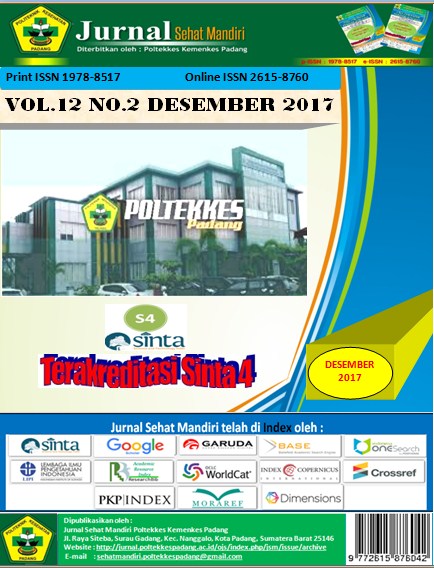Analisis Status Gizi Lansia dengan Beberapa Teknik Pengukuran Tinggi (tinggi lutut (knee height), Panjang Depa (arm span), dan Tinggi Badan (stature) di Padang Tahun 2015
Abstract
The increase in the number of seniors influence aspects of their lives. As a result of the aging process occurs with age is a decrease in bone mass that can alter the bone structure. Making it difficult to determine the nutritional status of the elderly, especially in determining badan.Tinggi height and weight used to measure body mass index (BMI) .Some known method to predict the height, among others, using the range of arm (arm span), and high-knee , The purpose of this study to look at the nutritional status of elderly people in ethnic Minang whether there is a difference by using variations in measurements at a different height with knee height), arm span, and stature. This research is an analytic study with cross sectional study design in Padang start of June - August 2015 in elderly aged> 60 years amounted to 81 people. Data collected in the form of weight data is measured using digital bathroom scales, height is measured by means microtoise, Knee Height is measured with a caliper in a sitting position, and fathoms long with a tool arm span and tested by independent ANOVA test.The results showed an average elderly for weight of 54.3 kg, stature of 151.5 cm, conversion knee height of 156.3 cm, arm span of 156.7 cm. The average BMI for stature of 23,2, knee height of 22.35 and arm span of 22.9. The average nutritional status with KMS for stature of 23,2, knee height of 21.75 and arm span of 21.37. There are differences in stature to the height of the knee in women and there are no differences in stature with a high knee in men. As for arm span there is a difference in stature of both men and women. There is no difference in the nutritional status of elderly with BMI and which refers to the KMS elderly. The absence of the differences in nutritional status, so it is advisable to health workers to take measurements of nutritional status of elderly with high measurement adapted to the conditions of the elderly. If the elderly can stand up to do the measurement of stature and if the elderly can not stand up well to do with stature measurements with the knee or arm span.
Downloads
References
2. Chumlea WC, Guo SS, Wholihan K, Cockram D, Kuczmarski RJ, Johnson CL. Stature prediction equations for
elderly non-Hispanic white, non-Hispanic black, and Mexican-American persons developed from NHANES III data. J Am Diet Assoc. 1998;98(2):137–42.
3. Darmajo R. Boedhi, dkk, 1999. Buku Ajar Geriatri, Jakarta: Balai Penerbit FKUI
4. Reeves SL, Varakim C, Henry CJ. The relationship between arm-span measurement and height with special reference to gender and ethnicity. Eur J Clin Nutri 1997; 50; 398-400.
5. World Health Organization. Physical status: the use and interpretation of anthropometri. Report of WHO Expert Committee. Geneva: World Health Organization, 1995; 854. World Health Organization Technical Report Series No 854.
6. Hurley RS, Bartlett BJ, Witt DD, Thomas A, Taylor EZ. Comparative evaluation of body composition in medically stable elderly. J Am Diet Assoc 1997; 97: 1105-9
7. Chumlea WC, Roche AF, Steinbaugh MI.Estimation of stature from knee height for persons 60 to 90 years of age. J Am Geriatr Soc 1985; 33: 116-20.
8. Meyers SA, Takiguchi S, Yu M. Stature estimated from knee height in elderly Japanese Americans.J Am Geriatr Soc 1994; 42: 157-60.
9. De Onis M, Habicht JP. Anthropometric reference data for international use: recommendation from the World Health Organization Expert Committee. Am J Clin Nutr 1996; 64: 650-8.
10.Fatmah. Persamaan (Equation) tinggi badan manusia usia lanjut (Manula) berdasarkan Usia dan Etnis pada 6 panti terpilih di DKI Jakarta dan Tanggerang tahun 2005. Makara Kesehat. 2006;10(1):7–16.
Copyright Notice
Pernyataan Hak Cipta dan Lisensi
Dengan mengirimkan manuskrip ke Jurnal Sehat Mandiri, penulis setuju dengan kebijakan ini. Tidak diperlukan persetujuan dokumen khusus.
Hak Cipta :
Lisensi Creative Commons Atribusi-NonKomersial-BerbagiSerupa 4.0 Internasional
Hak cipta atas artikel apa pun di Jurnal Sehat Mandiri dipegang penuh oleh penulisnya di bawah lisensi Creative Commons CC BY-NC-SA 4.0.
- Hak cipta pada setiap artikel adalah milik penulis.
- Penulis mempertahankan semua hak mereka atas karya yang diterbitkan, tak terbatas pada hak-hak yang diatur dalam laman ini.
- Penulis mengakui bahwa Jurnal Sehat Mandiri sebagai yang pertama kali mempublikasikan dengan lisensi Creative Commons Atribusi 4.0 Internasional (CC BY-NC-SA-4.0).
- Penulis dapat memasukan tulisan secara terpisah, mengatur distribusi non-ekskulif dari naskah yang telah terbit di jurnal ini kedalam versi yang lain (misal: dikirim ke respository institusi penulis, publikasi kedalam buku, dll), dengan mengakui bahwa naskah telah terbit pertama kali pada Jurnal Sehat Mandiri.
- Penulis menjamin bahwa artikel asli, ditulis oleh penulis yang disebutkan, belum pernah dipublikasikan sebelumnya, tidak mengandung pernyataan yang melanggar hukum, tidak melanggar hak orang lain, tunduk pada hak cipta yang secara eksklusif dipegang oleh penulis.
- Jika artikel dipersiapkan bersama oleh lebih dari satu penulis, setiap penulis yang mengirimkan naskah menjamin bahwa dia telah diberi wewenang oleh semua penulis bersama untuk menyetujui hak cipta dan pemberitahuan lisensi (perjanjian) atas nama mereka, dan setuju untuk memberi tahu rekan penulis persyaratan kebijakan ini. Jurnal Sehat Mandiri tidak akan dimintai pertanggungjawaban atas apa pun yang mungkin timbul karena perselisihan internal penulis.
Lisensi :
Jurnal Sehat Mandiri diterbitkan berdasarkan ketentuan Lisensi Creative Commons Atribusi-NonKomersial-BerbagiSerupa 4.0 Internasional (CC BY-NC-SA 4.0). Lisensi ini mengizinkan setiap orang untuk :
Menyalin dan menyebarluaskan kembali materi ini dalam bentuk atau format apapun serta menggubah, memperbaiki, dan membuat ciptaan turunan, bahkan untuk kepentingan komersial, selama mereka mencantumkan kredit kepada Penulis atas ciptaan asli.































